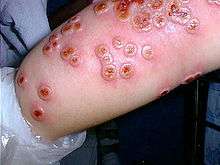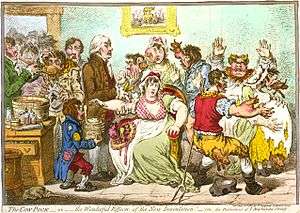Cowpox
| Cowpox virus | |
|---|---|
| Virus classification | |
| Group: | Group I (dsDNA) |
| Order: | Unassigned |
| Family: | Poxviridae |
| Subfamily: | Chordopoxvirinae |
| Genus: | Orthopoxvirus |
| Type species | |
| Vaccinia virus | |
| Species | |
|
Cowpox virus | |
Cowpox is an infectious disease caused by the cowpox virus. The virus, part of the orthopoxvirus family, is closely related to the vaccinia virus. The virus is zoonotic, meaning that it is transferable between species, such as from animal to human. The transferral of the disease was first observed in dairymaids who touched the udders of infected cows and consequently developed the signature pustules on their hands.[1] Cowpox is more commonly found in animals other than bovines, such as rodents. Cowpox is similar to, but much milder than, the highly contagious and often deadly smallpox disease.[1] Its close resemblance to the mild form of smallpox and the observation that dairymaids were immune from smallpox inspired the first smallpox vaccine, created and administered by English physician Edward Jenner.[2]
The word “vaccination,” coined by Jenner in 1796,[2] is derived from the Latin root vaccinus, meaning of or from the cow.[3] Once vaccinated, a patient develops antibodies that make him/her immune to cowpox, but they also develop immunity to the smallpox virus, or Variola virus. The cowpox vaccinations and later incarnations proved so successful that in 1980, the World Health Organization announced that smallpox was the first disease to be eradicated by vaccination efforts worldwide.[3] Other orthopox viruses remain prevalent in certain communities and continue to infect humans, such as the cowpox virus (CPXV) in Europe, vaccinia in Brazil, and monkeypox virus in Central and West Africa.
| Cowpox | |
|---|---|
| Classification and external resources | |
| Specialty | infectious disease |
| ICD-10 | B08.0 |
| ICD-9-CM | 051.01 |
| MeSH | D015605 |
.png)
Origin
Discovery
In the years from 1770 to 1790, at least six people who had contact with a cow had independently tested the possibility of using the cowpox vaccine as an immunization for smallpox in humans. Amongst them were the English farmer Benjamin Jesty, in Dorset in 1774 and the German teacher Peter Plett in 1791.[4] Jesty inoculated his wife and two young sons with cowpox, in a successful effort to immunize them to smallpox, an epidemic of which had arisen in their town. His patients who had contracted and recovered from the similar but milder cowpox (mainly milkmaids), seemed to be immune not only to further cases of cowpox, but also to smallpox. By scratching the fluid from cowpox lesions into the skin of healthy individuals, he was able to immunize those people against smallpox. Reportedly, farmers and people working regularly with cattle and horses were often spared during smallpox outbreaks. Investigations by the British Army in 1790 showed that horse-mounted troops were less infected by smallpox than infantry, due to probable exposure to the similar horse pox virus (Variola equina). By the early 19th century, more than 100,000 people in Great Britain had been vaccinated. The arm-to-arm method of transfer of the cowpox vaccine was also used to distribute Jenner's vaccine throughout the Spanish Empire. Spanish king Charles IV's daughter had been stricken with smallpox in 1798, and after she recovered, he arranged for the rest of his family to be vaccinated. In 1803, the king, convinced of the benefits of the vaccine, ordered his personal physician Francis Xavier de Balmis, to deliver it to the Spanish dominions in North and South America. To maintain the vaccine in an available state during the voyage, the physician recruited 22 young boys who had never had cowpox or smallpox before, aged three to nine years, from the orphanages of Spain. During the trip across the Atlantic, de Balmis vaccinated the orphans in a living chain. Two children were vaccinated immediately before departure, and when cowpox pustules had appeared on their arms, material from these lesions was used to vaccinate two more children.[5]
Jesty did not publicize his findings, and Jenner, who performed his first inoculation 22 years later and publicized his findings, assumed credit. It is said that Jenner made this discovery by himself, possibly without knowing previous accounts 20 years earlier. Although Jesty may have been the first to discover it, Jenner made vaccination widely accessible and has therefore been credited for its invention.
Implementation
Naturally occurring cases of cowpox were not common, but it was discovered that the vaccine could be “carried” in humans and reproduced and disseminated human-to-human. Jenner’s original vaccination used lymph from the cowpox pustule on a milkmaid, and subsequent “arm-to-arm” vaccinations applied the same principle. As this transfer of human fluids came with its own set of complications, a safer manner of producing the vaccine was first introduced in Italy, The new method used cows to manufacture the vaccine using a process called “retrovaccination,” in which a heifer was inoculated with humanized cowpox virus, and it was passed from calf to calf to produce massive quantities efficiently and safely. This then lead to the next incarnation, “true animal vaccine,” which used the same process but began with naturally-occurring cowpox virus, and not the humanized form.
This method of production proved to be lucrative and was taken advantage of by many entrepreneurs needing only calves and seed lymph from an infected cow to manufacture crude versions of the vaccine. W. F. Elgin of the National Vaccine Establishment presented his slightly refined technique to the Conference of State and Provincial Boards of Health of North America. A tuberculosis-free calf, stomach shaved, would be bound to an operating table, where incisions would be made on its lower body. Glycerinated lymph from a previously inoculated calf was spread along the cuts. After a few days, the cuts would have scabbed or crusted over. The crust was softened with sterilized water and mixed with glycerin, which disinfected it, then stored hermetically-sealed in capillary tubes for later use.
At some point, the virus in use was no longer cowpox, but vaccinia. Scientists have not determined exactly when the change or mutation occurred, but the effects of vaccinia and cowpox virus as vaccine are nearly the same.[6]

The virus is found in Europe, and mainly in the UK. Human cases today are very rare and most often contracted from domestic cats. The virus is not commonly found in cattle; the reservoir hosts for the virus are woodland rodents, particularly voles. From these rodents, domestic cats contract the virus. Symptoms in cats include lesions on the face, neck, forelimbs, and paws, and less commonly upper respiratory tract infections.[7] Symptoms of infection with cowpox virus in humans are localized, pustular lesions generally found on the hands and limited to the site of introduction. The incubation period is 9 to 10 days. The virus is prevalent in late summer and autumn.
Kinepox
Kinepox is an alternate term for the smallpox vaccine used in early 19th-century America. Popularized by Jenner in the late 1790s, kinepox was a far safer method for inoculating people against smallpox than the previous method, variolation, which had a 3% fatality rate.
In a famous letter to Meriwether Lewis in 1803, Thomas Jefferson instructed the Lewis and Clark expedition to "carry with you some matter of the kine-pox; inform those of them with whom you may be, of its efficacy as a preservative from the smallpox; & encourage them in the use of it..."[8] Jefferson had developed an interest in protecting Native Americans from smallpox, having been aware of epidemics along the Missouri River during the previous century. A year before his special instructions to Lewis, Jefferson had persuaded a visiting delegation of North American Indian Chieftains to be vaccinated with kinepox during the winter of 1801-2. Unfortunately, Lewis never got the opportunity to use kinepox during the pair's expedition, as it had become inadvertently inactive — a common occurrence in a time before vaccines were stabilized with preservatives such as glycerol or kept at refrigeration temperatures.
Historical use

After inoculation, vaccination using the cowpox virus became the primary defense against smallpox. After infection by the cowpox virus, the body (usually) gains the ability to recognize the similar smallpox virus from its antigens and is able to fight the smallpox disease much more efficiently.
The cowpox virus contains 186 thousand base pairs of DNA, which contains the information for about 187 genes. This makes cowpox one of the most complicated viruses known. Some 100 of these genes give instructions for key parts of the human immune system, giving a clue as to why the closely related smallpox is so lethal.[9] The vaccinia virus now used for smallpox vaccination is sufficiently different from the cowpox virus found in the wild as to be considered a separate virus.[10]
Prevention
Today, the virus is found in Europe, mainly in the UK. Human cases are very rare (though in 2010 a laboratory worker contracted cowpox.[11]) and most often contracted from domestic cats. Human infections usually remain localized and self-limiting, but can become fatal in immunosuppressed patients. The virus is not commonly found in cattle; the reservoir hosts for the virus are woodland rodents, particularly voles.[12] Domestic cats contract the virus from these rodents. Symptoms in cats include lesions on the face, neck, forelimbs, and paws, and, less commonly, upper respiratory tract infections.[8] Symptoms of infection with cowpox virus in humans are localized, pustular lesions generally found on the hands and limited to the site of introduction. The incubation period is 9 to 10 days. The virus is most prevalent in late summer and autumn.
Immunity to cowpox is gained when the smallpox vaccine is administered. Though the vaccine now uses vaccinia virus, the poxviruses are similar enough that the body becomes immune to both cow- and smallpox.
References
- 1 2 Vanessa Ngan, "Viral and Skin Infections", 2009
- 1 2 Thomas Cooper Library, University of South Carolina: "Edward Jenner and the Discovery of Vaccination", exhibition, 1996
- 1 2 Abbas, K. (2003). Cellular and Molecular Immunology (Fifth ed.). Philadelphia: Saunders. ISBN 0-7216-0008-5.
- ↑ Plett PC (2006). "[Peter Plett and other discoverers of cowpox vaccination before Edward Jenner]". Sudhoffs Arch (in German). 90 (2): 219–32. PMID 17338405.
- ↑ Tucker, Jonathan B. (2001). Scourge: The Once and Future Threat of Smallpox. New York: Atlantic Monthly Press. p. 31. ISBN 0-87113-830-1.
- ↑ Willrich, Michael (2011). Pox. New York: Penguin Books.
- ↑ Mansell, Joanne K.; Rees, Christine A. (2005). "Cutaneous manifestations of viral disease". In August, John R. Consultations in Feline Internal Medicine Vol. 5. Elsevier Saunders. ISBN 0-7216-0423-4.
- ↑ "Jefferson's Instructions to Lewis and Clark (1803)". Retrieved 2007-08-10.
- ↑ Moore, Pete (2001). Killer Germs: Rogue Diseases of the Twenty-First Century. London: Carlton. ISBN 1-84222-150-7.
- ↑ Yuan, Jenifer The Small Pox Story
- ↑ "Cowpox infection in US lab worker called a first".
- ↑ "Rat-to-Elephant-to-Human Transmission of Cowpox Virus". EID Journal. 14 (4): 670–671. 2008.
Sources
- Peck, David R. (2002). Or Perish in the Attempt: Wilderness Medicine in the Lewis & Clark Expedition. Farcountry Press. ISBN 1-56037-226-5.